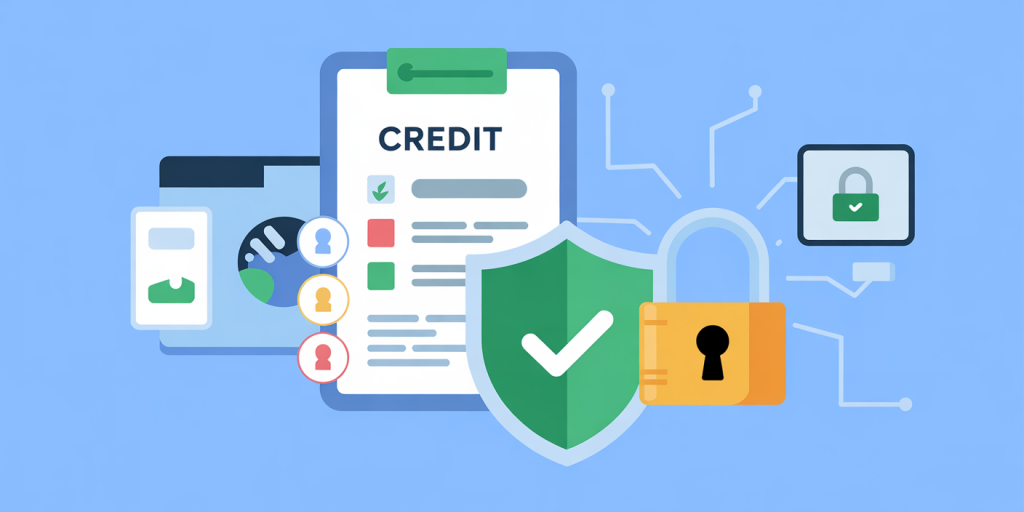Complete Guide to Credit Freezes and Fraud Alerts
Anúncios
In today’s digital age, identity theft and financial fraud have become significant threats to consumers. As cybercriminals grow more sophisticated, protecting your credit profile is increasingly essential. Two of the most effective tools offered by credit bureaus to help consumers shield their credit information are credit freezes and fraud alerts. Understanding how these tools work, when to use them, and their differences is crucial for safeguarding your financial identity.
Credit freezes and fraud alerts serve different purposes but share the common goal of reducing unauthorized access to your credit information. This guide will provide an in-depth overview of both protections, explain practical steps to activate them, compare their features, and explore future developments in credit security.
Understanding Credit Freezes: What They Are and How They Work
Anúncios
A credit freeze is a security measure that restricts access to your credit file, making it difficult for identity thieves to open new accounts in your name. When you place a freeze, lenders and other entities cannot access your credit report without your permission, effectively preventing fraudulent applications.

For instance, if a hacker tries to open a new credit card account using your stolen identity, the inability to view your frozen credit file will generally cause their credit check to fail. This process adds a robust layer of protection. However, because credit freezes limit access, you must temporarily lift or remove the freeze if you want to apply for new credit, rent an apartment, or even get some job offers that require a credit check.
Anúncios
According to the Federal Trade Commission (FTC), over 40 million Americans had credit freezes in place as of 2023, reflecting increased awareness of identity theft risks. The freeze is available free of charge from all three major credit bureaus: Equifax, Experian, and TransUnion. Consumers can activate, lift, or permanently remove freezes online, by phone, or by mail. Typically, a freeze request is processed within one business day.
What Fraud Alerts Do and When to Use Them
Fraud alerts are another type of credit protection that signals potential lenders and creditors to take extra precautions when verifying your identity. Unlike a credit freeze, a fraud alert does not restrict access to your credit file, but it does alert creditors that they should confirm your identity before issuing new credit.
There are primarily three types of fraud alerts: Initial fraud alert: Lasts for one year and is used when you suspect you have been or might be a victim of identity theft. Extended fraud alert: Lasts seven years and requires a police report to prove identity theft. This alert offers stronger protection by allowing you to receive free credit reports. Active duty alert: Intended for military personnel deployed overseas; identical in duration and impact to an initial alert.
For example, if your wallet was stolen but you haven’t seen any fraudulent charges yet, placing an initial fraud alert can help prevent unauthorized accounts from being opened. Unlike freezes, fraud alerts require creditors to reach out to you for verification before approving credit but still permit normal credit checks.
Fraud alerts have a notable advantage for people who are actively applying for credit since they do not hinder regular access to your credit files. A 2022 study by Javelin Strategy & Research found that consumers using fraud alerts saw a 15% reduction in identity theft incidents compared to those without any protection.
Key Differences Between Credit Freezes and Fraud Alerts
While both credit freezes and fraud alerts aim to prevent identity theft, their approach and impact differ significantly. The following table summarizes these differences:
| Feature | Credit Freeze | Fraud Alert |
|---|---|---|
| Restricts credit access | Yes | No |
| Duration | Until you remove or lift it | 1 year (initial), 7 years (extended) |
| Cost | Free | Free |
| Requires verification | Yes, when lifting freeze | Only for new credit applications |
| Effectiveness | High, blocks all new credit inquiries | Moderate, flagged for extra caution |
| Suitable for | Long-term protection when not applying for credit | When suspecting identity theft or applying for credit |
| Impact on credit approval | May delay or block credit approvals | May require additional verification but doesn’t block |
This comparison clarifies that a credit freeze provides stronger protection by completely blocking access to your credit file but can be inconvenient if you need to apply for credit frequently. Fraud alerts, on the other hand, maintain easier access but rely on lenders’ compliance to act cautiously.
How to Set Up Credit Freezes and Fraud Alerts
Activating either protection is a straightforward process that you can complete on your own. For credit freezes, contact each of the three major credit reporting agencies directly — Equifax, Experian, and TransUnion. You must provide proof of identity, such as your Social Security number, date of birth, address, and other personal details.
Example of initiating a credit freeze with Equifax:
1. Visit the Equifax freeze page online. 2. Enter required personal information and verify your identity via a one-time PIN sent to your phone or email. 3. Submit the request and receive confirmation.
For fraud alerts, it is sufficient to contact just one credit bureau. By federal law, that bureau must inform the other two bureaus and place fraud alerts on all reports. This simplifies the process for consumers.
Always keep a copy of confirmation numbers or PINs for freezes and alerts. When you want to lift a freeze — for example, ahead of applying for a mortgage — each credit bureau requires you to re-authenticate your identity using a PIN (for freezes) or simply update your fraud alert status online.
Practical cases highlight the utility of these protections. In 2019, a major medical data breach affected nearly 10 million patients. Many victims immediately placed credit freezes to prevent unauthorized new loans or credit cards, effectively reducing identity theft incidents reported to the FTC.
Limitations and Considerations When Using Credit Freezes and Fraud Alerts
While both tools offer essential preventive measures, they are not foolproof and have some limitations. Credit freezes do not prevent misuse of your existing credit accounts. For example, if a hacker gains access to an active credit card, placing a freeze will not stop fraudulent charges on that card. Therefore, monitoring your current accounts for suspicious activity remains necessary.
Similarly, fraud alerts rely heavily on creditor compliance. Not every creditor may thoroughly follow the alert protocol, especially smaller or less regulated firms. Consequently, fraud alerts may not always prevent all fraud attempts but do increase protection compared to having no alerts.
Another consideration is the impact on convenience. Credit freezes can delay legitimate applications for credit by requiring temporary lifting, which might pose challenges for urgent scenarios like emergency loans or quick apartment rental approvals.
Statistical data from the Identity Theft Resource Center shows that consumers who used a combination of credit freezes and fraud alerts had over 60% fewer fraud losses compared to those who relied solely on basic credit monitoring. This suggests that combining these tools, along with proactive credit monitoring, is the safest approach.
The Future of Credit Security: Emerging Trends and Innovations
The landscape of credit protection is evolving, driven by advancements in technology, regulatory changes, and increasing consumer demand for better security. One emerging trend is the use of biometric verification combined with traditional credit protections. Credit bureaus and lenders are exploring fingerprint or facial recognition systems as additional authentication layers before approving credit applications.

Furthermore, some fintech companies are developing real-time credit monitoring services integrated with artificial intelligence (AI) to detect suspicious behaviors instantly and alert consumers immediately. These innovations aim to minimize the window of opportunity for fraudsters.
Regulatory authorities are also considering mandating standardized procedures to enhance fraud alert effectiveness and streamline credit freeze management across states. For example, the proposed “Consumer Credit Protection Act” under discussion in Congress as of early 2024 includes provisions to simplify freeze removal and improve consumer education.
Practical applications of these trends exist today. Experian’s “IdentityWorks” leverages AI to monitor the dark web for stolen personal data and combines this with instant alerts when changes occur to your credit file. Similarly, some lenders now require multi-factor authentication for credit approval processes, enhancing fraud prevention.
The overall outlook suggests that as cyber threats continue to grow, consumers will benefit from more integrated, user-friendly credit protection options that combine traditional freezes and fraud alerts with cutting-edge technologies. Staying informed and proactive remains the best defense.

This comprehensive guide outlines the essential aspects of credit freezes and fraud alerts, crucial tools for anyone concerned about identity theft and credit fraud. Applying these protections wisely, understanding their differences, and staying ahead of technological trends will empower you to maintain control over your financial security.



Post Comment